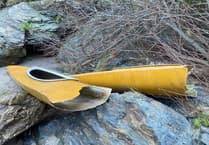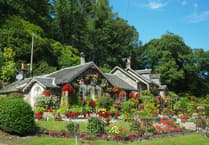In Nature Watch this week, photographer Ray Roberts shows us one of the common wildflowers growing locally and its past medicinal uses - as well as some to steer cleer of eating at all costs!
There are several wild flowers that were once used as medicine, from the 16th century onwards. Common comfrey – Symphytum officinalis – is one of them and a poultice made from its predominantly-veined leaves were used to treat sores and wounds but when packed around a broken limb and allowed to harden, as plaster of Paris is used today, it would mend the bone. Used for this purpose it earned the folk-names ’knitbone’ and ‘boneset’.
The plant likes to grow where the soil is damp and alongside a stream or river is usually the place to see it, but it can be seen in roadside ditches with flowers that can be white, purple or pink, but always the same colour on each plant.
Rosebay willowherb – Epilobium angustifolium – is a native plant that was grown in Victorian gardens but, as usual, it escaped and spread around the country, taking over bare and waste ground. It was one of the first plants to grow on the rubble of bombed-out buildings after the war, earning it the name ‘fireweed’. It has a tall stem, sometimes reaching one and a half metres high, with pink blooms.
At the end of summer its long fruit capsules split to release hundreds of plumed seeds that are carried away in the wind. The plant also spreads through stems below ground and if left unchecked will take over a large area, but as they say, one man’s meat is another man’s poison and I think a big group of flowers looks beautiful.
I was down beside the River Tiddy when a gaggle of noisy Canada geese went over, something that was lovely to see. I found some woody nightshade or bittersweet - Solanum dulcamara – with flowers that have five purple recurved petals with a contrasting yellow pyramid in the centre on a long and wiry branched stem that spreads over supporting vegetation.
Every bit of this plant is poisonous especially its red berries and its name, bittersweet, came about as the berries, if eaten, would first taste very bitter but they had a sweet after taste. And then sickness arrives. Woody nightshade is sometimes mistaken for the highly poisonous deadly nightshade – Atropa belladonna. A plant so poisonous that the famous 16th century herbalist John Gerard implored people to ‘Banish it from your gardens’.
There were a few tufts of quaking grass – Briza media – on a roadside grassy bank that I spotted on my way home. Now, this grass has almost flower-like seed heads on thin delicate stalks and when the wind blows, they virtually tremble and shake making a low rattling sound. Even approaching the grass wearing heavy walking boots starts the grass trembling giving it the nickname rattle grass. But, because it has very little foliage the grass in useless as cattle fodder.
I also found some red everlasting sweet pea flowers – Lathyrus latifolius – on the hedge. Introduced from central Europe as a garden plant but escaped into the countryside. As its name suggests this plant is perennial, not like the garden sweet pea that is only annual. Back in the village there are literally thousands of navelwort plants – Umbilicus rupestris – with their tall stems and green/white flowers, all over the hedges and walls.




